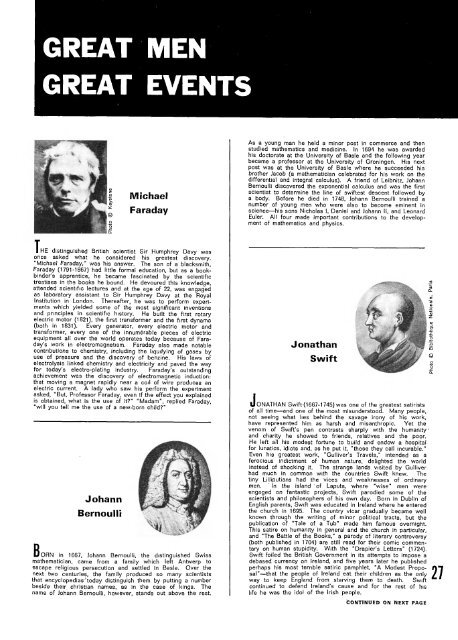Marie Curie; The Unesco courier: a window ... - unesdoc - Unesco
Marie Curie; The Unesco courier: a window ... - unesdoc - Unesco
Marie Curie; The Unesco courier: a window ... - unesdoc - Unesco
Create successful ePaper yourself
Turn your PDF publications into a flip-book with our unique Google optimized e-Paper software.
GREAT MEN<br />
GREAT EVENTS<br />
Michael<br />
Faraday<br />
As a young man he held a minor post in commerce and then<br />
studied mathematics and medicine. In 1694 he was awarded<br />
his doctorate at the University of Basle and the following year<br />
became a professor at the University of Groningen. His next<br />
post was at the University of Basle where he succeeded his<br />
brother Jacob (a mathematician celebrated for his work on the<br />
differential and integral calculus). A friend of Leibnitz, Johann<br />
Bernoulli discovered the exponential calculus and was the first<br />
scientist to determine the line of swiftest descent followed by<br />
a body. Before he died in 1748, Johann Bernoulli trained a<br />
number of young men who were also to become eminent in<br />
science his sons Nicholas I, Daniel and Johann II, and Leonard<br />
Euler. AH four made important contributions to the develop¬<br />
ment of mathematics and physics.<br />
T HE distinguished British scientist Sir Humphrey Davy was<br />
once asked what he considered his greatest discovery.<br />
"Michael Faraday," was his answer. <strong>The</strong> son of a blacksmith,<br />
Faraday (1791-1867) had little formal education, but as a book¬<br />
binder's apprentice, he became fascinated by the scientific<br />
treatises in the books he bound. He devoured this knowledge,<br />
attended scientific lectures and at the age of 22, was engaged<br />
as laboratory assistant to Sir Humphrey Davy at the Royal<br />
Institution in London. <strong>The</strong>reafter, he was to perform experi¬<br />
ments which yielded some of the most significant inventions<br />
and principles in scientific history. He built the first rotary<br />
electric motor (1821), the first transformer and the first dynamo<br />
(both in 1831). Every generator, every electric motor and<br />
transformer, every one of the innumerable pieces of electric<br />
equipment all over the world operates today because of Fara¬<br />
day's work in electromagnetism. Faraday also made notable<br />
contributions to chemistry, including the liquifying of gases by<br />
use of pressure and the discovery of benzine. His laws of<br />
electrolysis linked chemistry and electricity and paved the way<br />
for today's electro-plating industry. Faraday's outstanding<br />
achievement was the discovery of electromagnetic induction:<br />
that moving a magnet rapidly near a coil of wire produces an<br />
electric current. A lady who saw his perform the experiment<br />
asked, "But, Professor Faraday, even if the effect you explained<br />
is obtained, what is the use of it?" "Madam", replied Faraday,<br />
"will you tell me the use of a new-born child?"<br />
Johann<br />
Bernoulli<br />
B« FORN in 1667, Johann Bernoulli, the distinguished Swiss<br />
mathematician, came from a family which left Antwerp to<br />
escape religious persecution and settled in Basle. Over the<br />
next two centuries, the family produced so many scientists<br />
that encyclopedias'today distinguish them by putting a number<br />
beside their christian names, as in the case of kings. <strong>The</strong><br />
name of Johann Bernoulli, however, stands out above the rest.<br />
Jonathan<br />
Swift<br />
J, IONATHAN Swift(1 667-1 745) was one of the greatest satirists<br />
of all time and one of the most misunderstood. Many people,<br />
not seeing what lies behind the savage irony of his work,<br />
have represented him as harsh and misanthropic. Yet the<br />
venom of Swift's pen contrasts sharply with the humanity<br />
and charity he showed to friends, relatives and the poor.<br />
He left all his modest fortune to build and endow a hospital<br />
for lunatics, idiots and, as he put it, "those they call incurable."<br />
Even his greatest work, "Gulliver's Travels," intended as a<br />
ferocious indictment of human nature, delighted the world<br />
instead of shocking it. <strong>The</strong> strange lands visited by Gulliver<br />
had much in common with the countries Swift knew. <strong>The</strong><br />
tiny Lilliputians had the vices and weaknesses of ordinary<br />
men. In the island of Laputa, where "wise" men were<br />
engaged on fantastic projects, Swift parodied some of the<br />
scientists and philosophers of his own day. Born in Dublin of<br />
English parents, Swift was educated in Ireland where he entered<br />
the church in 1695. <strong>The</strong> country vicar gradually became well<br />
known through the writing of minor political tracts, but the<br />
publication of "Tale of a Tub" made him famous overnight.<br />
This satire on humanity in general and the church in particular,<br />
and "<strong>The</strong> Battle of the Books," a parody of literary controversy<br />
(both published in 1704) are still read for their comic commen¬<br />
tary on human stupidity. With the "Drapiers Letters" (1724).<br />
Swift foiled the British Government in its attempts to impose a<br />
debased currency on Ireland, and five years later he published<br />
perhaps his most terrible satiric pamphlet, "A Modest Propo¬<br />
sal" that the people of Ireland eat their children as the only<br />
way to keep England from starving them to death. Swift<br />
continued to defend Ireland's cause and for the rest of his<br />
life he was the idol of the Irish people.<br />
27<br />
CONTINUED ON<br />
NEXT PAGE
















